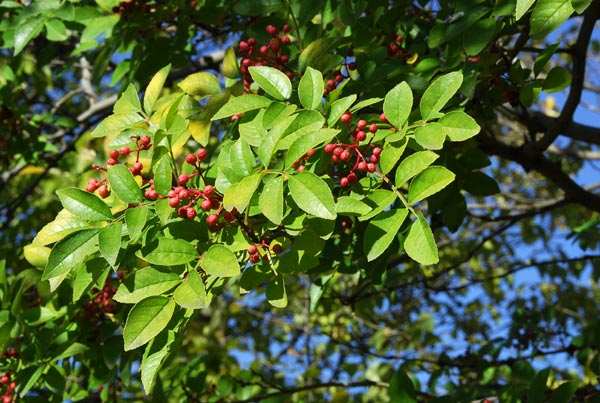Sichuan Pepper (Zanthoxylum spp.)
Sichuan pepper is a deciduous shrub or small tree, known for its vibrant red seed husks that deliver the distinctive tingling and numbing spice used in many Asian cuisines. Native to temperate parts of Asia, it thrives in New Zealand conditions — especially in sunny, well-drained locations across the upper North Island and sheltered parts of the South Island.
Botanical Features
-
Height/Spread: Typically grows 2–4 metres tall and wide, forming a rounded shape.
-
Leaves: Bright green, pinnate, with a citrus-like aroma when crushed.
-
Thorns: Sharp spines along stems — good for hedging and wildlife deterrent.
-
Flowers: Small, yellow-green clusters in spring.
-
Fruit: Reddish capsules that split open in late summer to autumn, revealing black seeds.
It’s often dioecious (separate male and female plants), though some self-fertile varieties exist.
Propagation from Seed
-
Harvest ripe seeds from split pods in late summer (Feb–Apr).
-
Soak seeds in warm water for 1–2 days.
-
Cold stratify in damp sand or vermiculite in the fridge for 6–10 weeks (June–Aug).
-
Sow in seed-raising mix in early spring (Sept–Oct), cover lightly, and keep warm and moist.
-
Germination may take 4–12+ weeks. Be patient!
Cultivation Tips
-
Climate: Prefers temperate to sub-tropical zones. Tolerates light frost once established.
-
Soil: Well-drained, loamy soil enriched with compost or organic matter.
-
Sun: Full sun to partial shade.
-
Water: Moderate watering — keep moist when young, drought-tolerant when mature.
-
Pruning: Light prune for shape and access; wear gloves due to thorns.
-
Spacing: Allow 2–3 metres between plants for airflow and growth.
Takes 3–5 years to begin fruiting under good conditions.
Uses and Benefits
-
Culinary: The dried husks add citrusy, floral heat to stir-fries, sauces, and spice mixes like Chinese five-spice.
-
Medicinal: Traditionally used to aid digestion and circulation, with mild antimicrobial properties.
-
Aromatic: Leaves and husks have a lovely scent — can be used in potpourri or as natural insect deterrents.
-
Pollinator-friendly: Flowers attract beneficial insects.
-
Edible landscaping: Beautiful and productive in one!
Sichuan Pepper in a Forest Garden
Sichuan pepper is an excellent mid-storey or edge plant in a forest garden design:
-
Works well beneath lightly spaced canopy trees like feijoa or chestnut.
-
Acts as a living barrier due to its thorny stems — great along borders or chicken runs.
-
Attracts pollinators and deters browsing animals (rabbits, possums).
-
Pairs well with nitrogen-fixers like tagasaste or clover nearby, to support soil health.
-
The aromatic mulch and litter layer helps repel pests and builds diversity.
In permaculture terms, it contributes to food, medicine, ecosystem balance, and natural pest control — all in one plant.


